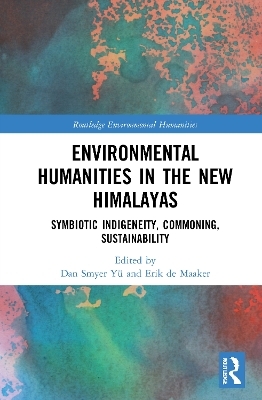
Environmental Humanities in the New Himalayas
Routledge (Verlag)
978-0-367-69981-9 (ISBN)
Environmental Humanities in the New Himalayas: Symbiotic Indigeneity, Commoning, Sustainability showcases how the eco-geological creativity of the earth is integrally woven into the landforms, cultures, and cosmovisions of modern Himalayan communities.
Unique in scope, this book features case studies from Bhutan, Assam, Sikkim, Tibet, Nepal, Pakistan, and Sino-Indian borderlands, many of which are documented by authors from indigenous Himalayan communities. It explores three environmental characteristics of modern Himalayas: the anthropogenic, the indigenous, and the animist. Focusing on the sentient relations of human-, animal-, and spirit-worlds with the earth in different parts of the Himalayas, the authors present the complex meanings of indigeneity, commoning and sustainability in the Anthropocene. In doing so, they show the vital role that indigenous stories and perspectives play in building new regional and planetary environmental ethics for a sustainable future.
Drawing on a wide range of expert contributions from the natural sciences, social sciences, and humanist disciplines, this book will be of great interest to students and scholars of environmental humanities, religion and ecology, indigenous knowledge and sustainable development more broadly.
Dan Smyer Yü is Kuige Professor of Ethnology in the School of Ethnology and Sociology, Yunnan University Kunming, China. Erik de Maaker is Assistant Professor in the Department of Cultural Anthropology and Development Sociology, Leiden University, The Netherlands.
Situating Environmental Humanities in the New Himalayas: An Introduction, Dan Smyer Yü Part I Kindred of the Earth, Deities, Humans and Animals 1. Relatedness, Trans-species Knots, and Yak Personhood in the Bhutan Highlands, Jelle J.P. Wouters 2. Lepcha Water View and Climate Change in Sikkim Himalaya, Charisma K. Lepcha 3. Eco-spiritual and Economic Perceptions in Bhutan’s Haa District, Thinley Dema Part II Aqueous Earth 4. Narratives from A Fluvial World: Poetics of Charland Dwelling in a Neocolonial Assam, Bhagarbi Das 5. Painting the Genesis of the Lepcha: A World Emerging from Water Spirits, Rongnyoo Lepcha and Mongfing Lepcha 6. Muddying the Waters: The Invention and Enclosure of Tibet’s Wetlands, Ruth Gamble Part III Evolving Cosmovisions, Climate Change and Community Resilience 7. Aloof but not Abandoned: Relationality and the Exploitation of the Environment in the Garo Hills of India, Erik de Maaker 8. Cordyceps, Climate Change and Cosmological Imbalance in the Bhutan highlands, Kinley Choki 9. Local Knowledge of Floods and Coping Strategies in Downstream Mahakali River, Nepal, Rashila Deshar, Dibas Shrestha, Sarina Maharjan and Madan Koirala Part IV Transboundary Environmentality and Indigenous Commoning 10. Indigenous Irrigation System Linking People, Place and the Planet: the Practice of jamfwi on the India-Bhutan Borderlands, Anwesha Dutta and Shailendra Yashwant 11. Rajaki: An Indigenous Approach to Commoning in Hunza, Pakistan, Zainab Khalid 12. Transboundary Environments, Militarization and Minoritization: Reimagining International Relations in the Himalaya from Ladakh, India, Alexander Davis 13. Symbiotic Indigeneity and Commoning in the Anthropogenic Himalayas, Dan Smyer Yü Conclusion: Indigenous Heritages and Sacred Earth, John Grim
| Erscheinungsdatum | 20.07.2023 |
|---|---|
| Reihe/Serie | Routledge Environmental Humanities |
| Zusatzinfo | 52 Halftones, black and white; 52 Illustrations, black and white |
| Verlagsort | London |
| Sprache | englisch |
| Maße | 156 x 234 mm |
| Gewicht | 480 g |
| Themenwelt | Sozialwissenschaften ► Ethnologie |
| Sozialwissenschaften ► Soziologie | |
| ISBN-10 | 0-367-69981-8 / 0367699818 |
| ISBN-13 | 978-0-367-69981-9 / 9780367699819 |
| Zustand | Neuware |
| Informationen gemäß Produktsicherheitsverordnung (GPSR) | |
| Haben Sie eine Frage zum Produkt? |
aus dem Bereich


